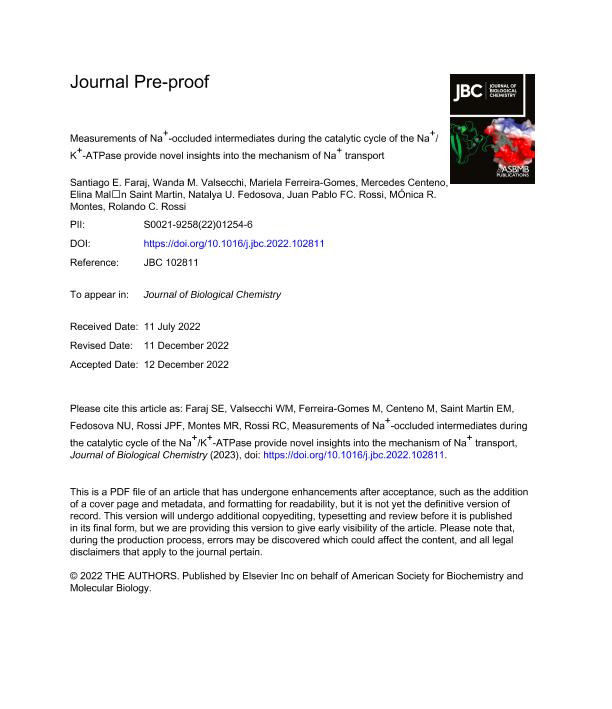Artículo
Measurements of Na+-occluded intermediates during the catalytic cycle of the Na+/K+-ATPase provide novel insights into the mechanism of Na+ transport
Faraj, Santiago Enrique ; Valsecchi, Wanda Mariela
; Valsecchi, Wanda Mariela ; Ferreira Gomes, Mariela Soledad
; Ferreira Gomes, Mariela Soledad ; Centeno, Mercedes; Saint Martin, Elina Malén
; Centeno, Mercedes; Saint Martin, Elina Malén ; Fedosova, Natalya U.; Rossi, Juan Pablo Francisco
; Fedosova, Natalya U.; Rossi, Juan Pablo Francisco ; Montes, Monica Raquel
; Montes, Monica Raquel ; Rossi, Rolando Carlos
; Rossi, Rolando Carlos
 ; Valsecchi, Wanda Mariela
; Valsecchi, Wanda Mariela ; Ferreira Gomes, Mariela Soledad
; Ferreira Gomes, Mariela Soledad ; Centeno, Mercedes; Saint Martin, Elina Malén
; Centeno, Mercedes; Saint Martin, Elina Malén ; Fedosova, Natalya U.; Rossi, Juan Pablo Francisco
; Fedosova, Natalya U.; Rossi, Juan Pablo Francisco ; Montes, Monica Raquel
; Montes, Monica Raquel ; Rossi, Rolando Carlos
; Rossi, Rolando Carlos
Fecha de publicación:
01/2023
Editorial:
American Society for Biochemistry and Molecular Biology
Revista:
Journal of Biological Chemistry (online)
ISSN:
0021-9258
Idioma:
Inglés
Tipo de recurso:
Artículo publicado
Clasificación temática:
Resumen
The Na+/K+-ATPase is an integral plasma membrane glycoprotein of all animal cells that couples the exchange of intracellular Na+ for extracellular K+ to the hydrolysis of ATP. The asymmetric distribution of Na+ and K+ is essential for cellular life and constitutes the physical basis of a series of fundamental biological phenomena. The pumping mechanism is explained by the Albers–Post model. It involves the presence of gates alternatively exposing Na+/K+-ATPase transport sites to the intracellular and extracellular sides and includes occluded states in which both gates are simultaneously closed. Unlike for K+, information is lacking about Na+-occluded intermediates, as occluded Na+ was only detected in states incapable of performing a catalytic cycle, including two Na+-containing crystallographic structures. The current knowledge is that intracellular Na+ must bind to the transport sites and become occluded upon phosphorylation by ATP to be transported to the extracellular medium. Here, taking advantage of epigallocatechin-3-gallate to instantaneously stabilize native Na+-occluded intermediates, we isolated species with tightly bound Na+ in an enzyme able to perform a catalytic cycle, consistent with a genuine occluded state. We found that Na+ becomes spontaneously occluded in the E1 dephosphorylated form of the Na+/K+-ATPase, exhibiting positive interactions between binding sites. In fact, the addition of ATP does not produce an increase in Na+ occlusion as it would have been expected; on the contrary, occluded Na+ transiently decreases, whereas ATP lasts. These results reveal new properties of E1 intermediates of the Albers–Post model for explaining the Na+ transport pathway.
Archivos asociados
Licencia
Identificadores
Colecciones
Articulos(IQUIFIB)
Articulos de INST.DE QUIMICA Y FISICO-QUIMICA BIOLOGICAS "PROF. ALEJANDRO C. PALADINI"
Articulos de INST.DE QUIMICA Y FISICO-QUIMICA BIOLOGICAS "PROF. ALEJANDRO C. PALADINI"
Articulos(IQUIMEFA)
Articulos de INST.QUIMICA Y METABOLISMO DEL FARMACO (I)
Articulos de INST.QUIMICA Y METABOLISMO DEL FARMACO (I)
Citación
Faraj, Santiago Enrique; Valsecchi, Wanda Mariela; Ferreira Gomes, Mariela Soledad; Centeno, Mercedes; Saint Martin, Elina Malén; et al.; Measurements of Na+-occluded intermediates during the catalytic cycle of the Na+/K+-ATPase provide novel insights into the mechanism of Na+ transport; American Society for Biochemistry and Molecular Biology; Journal of Biological Chemistry (online); 299; 2; 1-2023; 1-34
Compartir
Altmétricas



